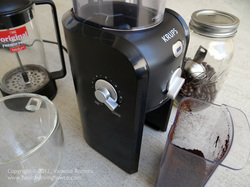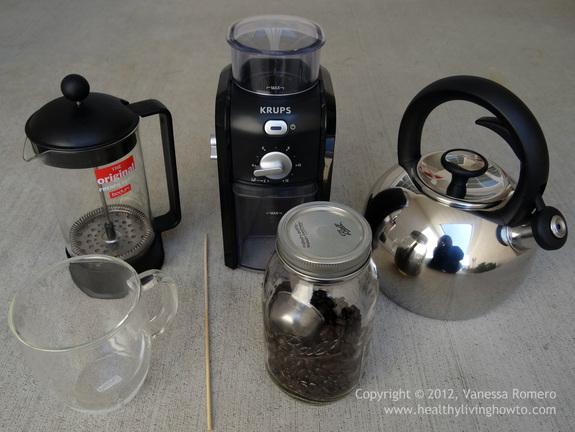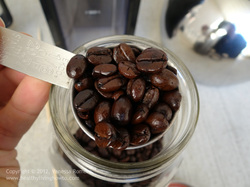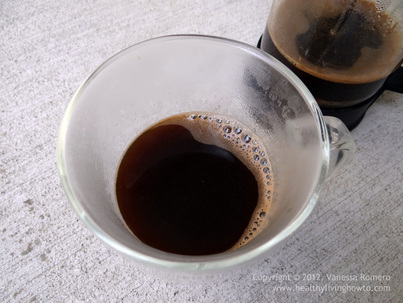Tom and I love, love, love our morning cup of coffee. It's a routine and ritual; wake-up, crawl out of bed, make a quick detour through the bathroom ending in front of the coffee maker. We've been dedicated single-serve coffee maker fans for a number of years, favoring the Keurig since it arrived on the market. Neither of us typically drink more than a cup in the morning and perhaps a second cup in the afternoon, so brewing a whole pot of coffee is not necessary.
We enjoy dark roast, rich and bold, coffee you can chew on. It is important to us to avoid pesticides and chemicals, choosing organic coffee when possible. If it's fair trade as well, then double bonus. Unfortunately, that doesn't leave us with a very large selection of Keurig coffees. Recently, Tom has been eyeing up coffee beans on our weekly shopping trip, wanting to try some different varieties of coffee. This weekend we decided to pick up a few scoops of beans, an organic and fair trade French roast, stocked fresh that very same day. Instead of using our Keurig refillable k-cup (which is messy and doesn't work well), I dusted off our French press, bought a new coffee grinder and put on my barista apron.Making a good cup of coffee in a French press is more an art than a science. There are a few steps to follow, but beyond that, dedicated French press users all have their own “recipe”. Here are some basic tips to make the perfect cup.
HOW TO MAKE FRENCH PRESS COFFEE
1 THE BEANS
 Fresh beans equal good coffee. Look for beans that are roasted on the premise or nearby and stocked regularly. Quality establishments will display roasting date and/or stock date, so you know exactly how fresh your coffee is.
Fresh beans equal good coffee. Look for beans that are roasted on the premise or nearby and stocked regularly. Quality establishments will display roasting date and/or stock date, so you know exactly how fresh your coffee is.
Coffee taste is at its peak 1-3 days after it is roasted. If stored properly, it will last two weeks. You should never store coffee beans in the refrigerator or freezer. Coffee actually absorbs the smells and tastes from surrounding foods and freezing will change the oil properties of the beans. Whole beans should be stored in an air tight container and stored in a cool, dry and dark place.
2 THE WATER
 Always use cold, filtered water. The quality of the water being used is important. If your water isn't filtered, consider getting a faucet filter. Tap water with an odor or taste will come through in the coffee.
Always use cold, filtered water. The quality of the water being used is important. If your water isn't filtered, consider getting a faucet filter. Tap water with an odor or taste will come through in the coffee.
3 THE GRIND
 Coffee beans start to lose their flavor immediately after being ground. As tempting as it is, do not grind your beans at the store. Instead, grind your beans right before you brew. The coarseness of the grind is determined by brewing time and filter. A coarse grind is recommended for the French press method.
Coffee beans start to lose their flavor immediately after being ground. As tempting as it is, do not grind your beans at the store. Instead, grind your beans right before you brew. The coarseness of the grind is determined by brewing time and filter. A coarse grind is recommended for the French press method.
4 THE MEASURES
A standard cup of coffee is 6 fluid ounces or 3/4 cup. For every cup of coffee, 2 Tablespoons of coffee is required.
5 THE FRENCH PRESS
Bring water to a boil, remove from heat source, then wait a minute or two. Grind the beans into a uniform coarse to medium-coarse ground. Place grounds in French press, pour water over top and stir with a non-metal utensil. Place plunger in press, making sure the filter is just above the beans but not touching. Steep for 4-10 minutes, the longer the steeping time, the darker the coffee. Push plunger very slowly straight down.
Over the weekend we enjoyed more than a few cups of French press coffee and dare I say I might retire our Keurig, at least for a little while. The beans we selected were from Whole Foods, Allegro Organic Fair Trade French Roast. I highly recommend them if you like a sweet, smoky and smooth dark roast coffee. With some homemade coconut coffee creamer and a dash of vanilla stevia it is divine.



